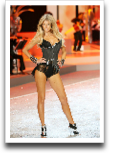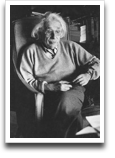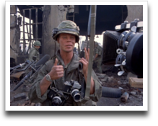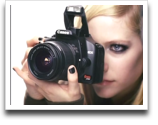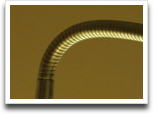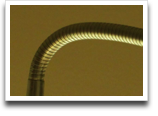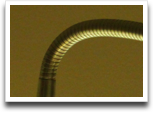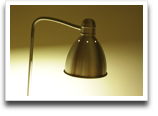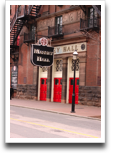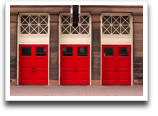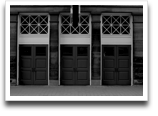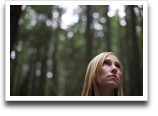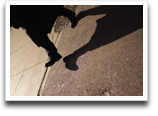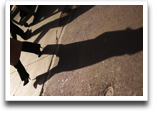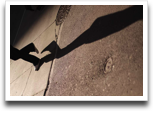This journal documents my experiences with a Canon 50D, my
first DSLR camera, purchased on Oct. 16, 2008. It has some of my
photographs taken with the 50D, comments about the camera's usability
and suggestions for improvement. It also has links to
photography-related sites which I found interesting.
My first digicam was the S30. I chose the Canon brand after
playing with a Canon EOS SLR camera (belonging to a faculty member in
the department). What amazed me about that camera was that Canon
developed technology that tracked your eye and focused the lens wherever
you looked (ECF, eye-controlled focusing). My most recent camera was the
Canon S60, which is in need repair.
Moon Shot
photo • low light
Mon Dec 01 13:58:20 2008
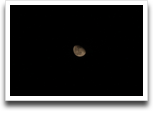 |
|
The Moon. Shutter Priority 1/640s, f/1.4 [1 of 15]
|
A few weeks ago, just before bed, I happened to take a look
outside my window, just before getting into bed when I noticed that
the sky was clear and the moon was out— I just had to take
some pictures.
Before getting dressed, I checked my journal entry where I
recorded the camera settings for the last lunar eclipse I had
photographed. I then got dressed and hopped out onto the balcony
with my 50D and began photographing the moon. I leaned the camera
on the balcony railing for stability, but because of the distance
and my 50mm lens, even the slightest vibration like the shutter
clicking added jitter to the photograph.
As I was coming back in, I bumped the base of the camera on the
sliding door quite severely (if it had been a piece of wood, it
would have nicked the wood). Once inside, I carefully checked the
body of camera for a dent or a paint bruise— nothing, not
even a scratch— phew!.
Update Wed Dec 03 15:54:47 2008: I was re-reading the
manual last night and I realize I should have changed the metering
mode from Evaluative to Center-Weighted as the subject I am
photographing is in the center, and surrounded by blackness.
Update Sat Dec 06 20:17:04 2008: I was taking some night
photographs of the freshly fallen snow and playing with the
metering modes, I found that Partial Metering produced better
exposed photographs (at -2/3 EV).

Victoria's Secret Fashion Show
photos • super models
Wed Dec 03 13:54:49 2008
There are charms made only for distant
admiration.
—Samuel Johnson
My guess is that Canon cameras were used to photograph
the 2008
Victoria's Secret Fashion Show.
Note that the site is in Russian, but that doesn't really matter
as the subject matter is universal.

Portfolio: Ernst Haas
photographer
Fri Dec 05 08:48:28 2008
Superb black and white photography and portraits of celebrities
(including Einstein) by Ernst
Haas.
His behind-the-scenes photographs on the set of The
Misfits are the last memorials to Marilyn Monroe's career.
Other than the first photograph in the series, I can't say I was
impressed with his photographs of Audrey Hepburn's wedding; the
photos have a distant, rather than intimate quality to them.
His colour photography is breathtaking in framing (see
"Locksmith's Sign" in the New York series), composition and
contrasts— he makes photography look so easy.

"canon" vs. "nikon"
rivalry
Fri Dec 05 14:07:41 2008
Using Google Insight for Search, I
tried "canon"
and "nikon". The results are similar to the search for "ipod"
and "zune" (except that the search volume is 60% greater for
"ipod")— Nikon is the Zune of photography. Seasonal peaks for
all four terms are also similar (peaking in December).

"Full Metal" Nikon
cinema
Sat Dec 06 20:05:48 2008
I was watching Kubrick's Full Metal Jacket and I noticed
that the "Stars and Stripes" journalists and photographers used
Nikon cameras.
There are about three scenes where the photographer is shown in
either a closeup or medium shot where the Nikon camera logo is
clearly visible. The equipment of the film camera crew interviewing
them is also featured prominently— in one interview, the
Arriflex logo on the camera is clearly visible.
Update Sun Dec 07 10:53:29 2008: According to
an IMDB cinema
goof, "The chrome Nikon FTN that is stolen from Rasterman would
NEVER have been used in VietNam. First, the FTN metering head would
be useless in a dirty humid environment like that. Second a
reflective chrome body would never be used in a war situation as it
could give away the photographer's position. Third, a noisy SLR
like a Nikon F would also never be used for the same reason."

1980s Japanophobia
philosophy
Sun Dec 07 00:03:59 2008
Eric pointed me to this entry in Philip Greenspun's blog
praising
Canon and Japanese philosophy (zen?) in general, after
fearing and loathing the Rising Sun in the early 80s.
One question that still remains is whether Japanese cars
(kaizen?) killed the U.S. auto industry or whether it
committed suicide (not so much seppuku as ju-monji
giri) with the U.S. consumer standing by as
the kaishakunin?

My Google Rank; Avril Lavigne is a Rebel
Wed Dec 10 04:07:47 2008
This journal ranks 185th (18th page) out of more than 4M results for the
search terms, 'canon 50d'.
I haven't done much outdoor shooting because the weather has been
wet and miserable which, in turn, makes me miserable. I did do an
indoor ISO study which I have to report on.
It seems Avril Lavine is marketing the Canon Rebel Xsi and one of
the Elph line that comes in pink. I never thought of her or her
fans as DSLR users. Perhaps Canon sees an untapped photography
market in the skater crowd which prefer video cameras to record
their antics.
Wed Dec 10 22:48:12 2008: David comments:
First off, she's attractive, so if she appears on television there's a
good chance male audiences will stick around to see what things are
about.
Second, given that many people have labelled her as "punk" (which she
rejects incidentally), is it any surprise that they're using her for a
product called "Rebel"? Remember that Agassi was the first spokesmen
for the Rebel line, and he had quite a reputation for language.

Yikes!
photography
Thu Dec 11 22:21:05 2008
David sent me to Sandy Huffaker Jr.'s blog where
he describes
being on the scene and photographing the recent F-18
crash. The New York Times
carried some of his photographs.
If he had only run outside with his camera the first time, he
would have had a shot of the pilot parachuting down. And he broke
one of my rules— always wear the neckstrap when
shooting/holding/carrying the camera— he accidently dropped
his camera and destroyed his 16-35mm (L!) lens. The other reason I
wear my neckstrap is to alleviate hand fatigue due to the camera's
weight.

Flickr to the Rescue
captions
Fri Dec 12 17:14:55 2008
A pilot project begun by the Library of Congress allowing Flickr
users to tag and comment on 3,000 historic photographs in the
Library's collection, has been
a great success and
will continue.
It's ironic that Flickr staff have been laid off by Yahoo.

Update Sun Dec 21 13:59:27 2008: Here is the blog entry of
the Commons designer, George
Oats, being
fired. I'm sure google will scoop her up as they need good designers.
BCE Place Galleria
photo
Fri Dec 12 19:48:34 2008
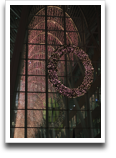 |
Christmas decorations at the Bay street
entrance of the BCE Place Galleria. In Program mode, handheld,
-1/3EV, f/2, WB: Tung, 1/60s, 400 ISO. [1 of 4] |
This photograph was taken on Dec. 3rd, on my walk home, one block
north of Union Station. I didn't take any photographs during the
walk because it was cold and windy.

ISO Study
study
Sat Dec 13 13:41:22 2008
| Name | f-stop | ISO | Shutter | Size (MB) |
|---|
| IMG_9696 | f/5 | 400 | 1/45 | 2.96 |
| IMG_9697 | f/5 | 800 | 1/85 | 3.51 |
| IMG_9699 | f/6.3 | 1600 | 1/8 | 3.83 |
| IMG_9702 | f/11 | 3200 | 1/6 | 4.32 |
The table above shows the camera settings for some of the photos
taken. An increasing ISO, delivers faster shutter speeds, larger
f-stops, more "noise", and increased file size— which I
didn't expect, but which makes sense. The sensor noise is quite
apparent at ISO 3200 (when viewing full-screen on my Mac, and even
when looking closely at the third thumbnail, above) and any
photographs with large expanses of uniform colours will look
disappointing, as will portraits.
The 50D is quite an improvement over my S60 at ISO 400 giving
noiseless low-light photographs.
Update Sun Dec 14 00:04:59 2008: David suggests another
study:
Did you try taking pictures with a 'medium' setting (8 MP) for JPEGs?
The entire sensor is still being used, but since every pixel isn't
saved to the final JPEG, the processor can take the "extra" values and
use them to extrapolate the image and perhaps gloss over some of the
artifacts.
The 8 MP potentially looks cleaner, but the obvious trade off is that
you have fewer to do crops with. At 8 MP you can print up to an 8"x11"
at 300 ppi (or 16x12 @ 200 ppi).
He also
collected 3200
ISO 50D photos posted to Flickr. What is immediately noticeable
is the lack of sensor noise. I picked one at random (the baby Belah
picture) and looked at the properties— even though it was
taken at 3200 ISO, I think it didn't have to be; looking at the
shutter speed, and f-stop, it could have been taken handheld at 800
or even 640 ISO. Meaning, that there was plenty of light
available to obscure sensor noise.

Massey Hall
photos
Sun Dec 14 10:00:08 2008
I see a red door and I want it painted black
No colors anymore I want them to turn black
—"Paint it Black"
I also have a photograph of the clock just inside the doors. I
happened to be passing by when the roadies for the Smashing
Pumpkins were setting up, a few weeks ago, and the three red doors
were open.

Portfolio: Heath Korvola
photos
Mon Dec 15 17:41:23 2008
Great photographs
with unique framing, suitable for catalogs (outdoor equipment),
brochures (travel, publicity) and stock photography. Nearly every
picture breaks the rule of thirds.
Don't miss his 'text messages' gallery under 'projects'.
I guessed that his portfolio was shot with a Nikon; I was right.
But according
to his
blog, he's switched and his Canon 5D MkII will be arriving
soon.

This is What the 50mm f/1.4 is Best At
photo
Tue Dec 16 18:04:26 2008
 |
|
This photograph is why I love this camera and the
50mm f/1.4 lens.
You get indoor shots (lit with only a single
overhead bulb and back-lit
with daylight through the window)
of amazing clarity and tone
in Aperture Priority, 100 ISO and
f/1.4. [1 of 6]
|
Prints
I got some prints made today at Blacks on Yonge and Dundas (4x6
cost 10 cents now!) and the photos look amazing! I tried the Fuji
InstaPrint kiosk first— the photo-choosing interface is very
confusing— but just as I went to print, the kiosk informed me
that the printer (in a locked enclosure below) was jammed. So I had
to wait in line to let someone know that the printer had jammed. I
thought it would be something simple, but the unjamming actually
involved replacing "the ribbon" (a roll of CYMK film) that had
disintegrated inside the printer. So I cancelled my order and
decided to go with the "old fashioned" 1-hour photo. To top it off,
they couldn't find my 8x10 print so I had to go back twice.
1600 ISO
During a birthday party this weekend (a very cloudy day, so all
the light was from indoor lamps) I had to photograph three kids who
had gorged themselves on chocolate cake. I had no choice but to
spin the dial to 1600 ISO (handheld 1/20s shutter speeds using
A-DEP mode) and I was impressed with the lack of noise in the
shots.
I will now have to do a study of high ISO photography in indoor
daylight.
Nikon D3 Spotting
I saw a photographer (white haired) with a Nikon D3 (on the strap)
with a telephoto lens (I'm guessing 200mm), today at King and Bay
photographing a York University picket line. Should have taken my
camera today as it was a beautiful sunny day (but with a -10 °C
wind-chill)...

"The Decisive Moment"
photos cartier-bresson
Wed Dec 17 00:05:04 2008
Henri Cartier-Bresson's famous
book, "The
Decisive Moment", with a cover designed by Matisse, is
available for viewing in a flash player.

Port Credit Bus Stop
photo
Wed Dec 17 14:22:02 2008
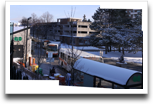 |
|
Mississauga Transit bus stop for Route 19 (north
to Square One) at Port Credit GO station this morning, while
waiting for my train (which was late). 4 image panorama painfully
stitched together (it took 15 minutes from the time I began the
stitch to the time I had a 1200x733 240K JPEG from the original
102M JPEG).

|
1600 ISO
photo low light
Thu Dec 18 17:37:23 2008
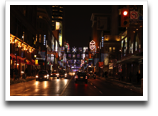 |
|
Last night, on my way home, I took some 1600 ISO
pics of Yonge street, looking north from Richmond. This is the best
of them all (1200x800 reduced from the original).
Program
mode, f/2.8, Partial metering, 1/125s, WB: Cloudy, EV: -1.3 [1 of
8]
|
1600 ISO gives great handheld shutter speeds (The picture above
was taken from the middle of the crosswalk, where there are no
lamp-posts to hold your camera against) and no noticeable sensor
noise if exposed appropriately. I have a couple underexposed photos
taken prior to this one and there is no apparent sensor noise.
However, doing a Auto Smart Fix in Photoshop brings out the
details in the dark areas of the photograph, but also makes the
sensor noise and grain more evident.

Great Dane
photo
Fri Dec 19 17:43:49 2008
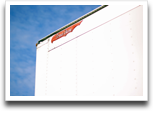 |
|
This is a serendipitous picture of the top left
corner of a trailer that has been parked for the last few months. I
took it right after shooting in the shade, without adjusting the
either the exposure or the aperture settings for bright
sunlight. SmartFixed in Photoshop Elements. [1 of 1]
|
The original was completely blown-out, but running it through
SmartFix produced a peculiar green shadow under the top rim that
complements the red logo. The purple fringing is the chromatic
aberration inherent in this lens. The only thing that would make
this picture excellent, would have been an interesting cloud
formation in the sky.
Update Fri Dec 19 22:34:12 2008: A note on framing: I
noticed that rather than framing the shot with the edge of the top
of the trailer intersecting with the top-right corner of the
photograph (conforming to the rule of thirds), I framed it with the
lower horizontal line intersecting with the corner; which gives
more metal and less sky.
I only realized I broke the rule of thirds when I added this photo
to the banner on this page and the red logo was not framed properly
within the banner area.
I don't remember conciously framing this picture in this way so I
can't say why it's so— perhaps I wanted to show the enormity
of the trailer and put more of it in the frame; or perhaps I wanted
to show the pedestrian's perspective of this trailer was I walked
past it everyday.
I have added it to my list of desktop wallpaper which has so far
only included macro photography. Update Wed Dec 24 17:59:32
2008: I have removed it from the rotation because the trailer
is too bright for a desktop background.

Ken Rockwell Agrees with Me
usability rivalry canon nikon
Sun Dec 21 12:42:55 2008
One of my irritants is the inability to
zoom an image being previewed right after a shot is taken, without
first pressing the "Play" button to enter review mode.
I happened to be looking around Ken Rockwell's site after Eric
sent me a link
to one
of his Route 66 photo studies and I happened upon a page where
he compares
the Nikon D3, 300 and the Canon 5D and I was surprised to read:
The downsides of the 5D are that it's a pain to use. Everything takes
a few more button pushes than any of the Nikons. Want the LCD to
magnify the shot you just took? You have to press the Play button and
wait a moment, while on every Nikon you just press the mag button, instantly.
Clearly the people at Canon who designed the usability of this
camera must not be photographers.
I found another irritant while taking photographs at night, when
it's difficult to see what exposure mode you're in e.g. Shutter
Priority or Aperture Priority: with the rear LCD on, if you switch
from one mode to another, the LCD shuts off. I have to keep turning
on the LCD, by pressing the joystick, every time I switch
modes— again one extra, unnecessary keypress.
I also agree with him that Nikon photographs people better
(especially in low light) and Canon photographs landscapes better;
my opinion is just based on viewing people's photographs.
Update Sun Dec 21 13:57:11 2008: Canon feature request: I
like the idea of having certain camera settings reset to
"normal":
Resets are important, because every night I usually wind up my camera
to ISO 1,600 and some screwy custom white balance, flash mode and
exposure compensation, and every morning I need to set it all back to
ISO 100 and normal. With the Canons I need to run down a long
checklist of about a dozen things I may have messed with, because I
can't use their reset because it resets too much, meaning I would
have to go down an even longer checklist to reset the strategic items.
Update Mon Dec 22 10:34:20 2008: David found further
evidence that Canon cameras are designed by non-photographers:
You're not the first person to make this observation:
A friend once said to me that Canons are the best cameras available
designed by engineers, and that Nikons are the best cameras one can
buy designed by photographers. There may well be some truth to
this aphorism.

George Oats Should Work for Google
flickr picasa
Sun Dec 21 22:11:51 2008
I think George Oats should send her resume to
Google and apply to work on Picasa, which can become the new
Flickr.

Snow Illusion
photos
Mon Dec 22 02:52:35 2008
Impressions made in
freshly fallen snow and photographed from the right angle trick the
brain into believing something that's not really there.

Street Photography
photos
Tue Dec 23 15:14:02 2008
When one speaks of street photography, one typically imagines
photographs taken with a 16mm or 24mm lens set at f/8 or
f/11— the style that Cartier-Bresson pioneered in
Europe. Bruce
Gilden is an exception to this style; his street photography is
up close and personal. (Update Wed Dec 31 16:32:47
2008: video profile.)
I tried shooting some street photography with my (equivalent) 85mm
lens set at f/8 and the results were terrible— the photos
looked flat— like they were taken with a point-and-shoot digicam. I
also tried some f/1.4 shots, which looked a lot better; they had
depth to them.
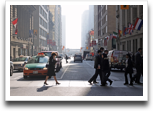 |
|
This photograph was taken right after the "iPod
Bliss" photograph (as I walked east from the TTC stop), looking
south at Yonge and King (from the north crosswalk). The
multi-national flags are from the hotel at 1 King West. The woman
on the left was inspiration for a study I did, a few days later, of
people and their shadows crossing the street. [1 of 1]
(SmartFixed)

|
Me and My Shadow
photos
Wed Dec 24 12:08:19 2008
Controlled intersections have the interesting characteristic of
being able to be photographed every 30 seconds. This gave me 30
seconds to review my photographs while waiting for the light to
change again. I spent about 4 minutes photographing this corner of
the intersection.
I think I would have to spend a few hours to get a really
interesting photograph; I took one of a man with a cane, but other
overlapping shadows spoiled it.

Composition
technique
Thu Dec 25 10:24:34 2008
David sent me a link
to an article on the Wikipedia about
visually composing images. I followed several of the external links
and I found photoinf.com to have
the best collection of articles on the subject.
Here is a list of the ones that had good examples illustrating the
concepts:

Flickr is the Slashdot of Photography
commentary
Thu Dec 25 15:53:33 2008
If your camera has a built-in flash, it's not a
professional camera.
The closest I've ever come to uploading my photos to Flickr, was
to create an account (which was so long ago, that I've forgotten
both the account name and password) which I never used.
My biggest reason for avoiding Flickr is that the loudmouth
amateur is indistinguishable from the consumate
professional. Looking at
the latest
statistics on camera usage, there seems to be a distinct lack
of professionals (Canon Rebels are the most popular with the iPhone
climbing in popularity) . It would surprise me if most of
those photos weren't taken in Full Auto mode. Shooting in full auto, or
in one of the presets, it's virtually impossible to take bad
photographs unless it's beyond the capabilities of the camera.
Aside: many years ago, on a gray, overcast day, I remember a woman
photographing the train with her SLR (it was a silver grey SLR,
likely a Canon Rebel) as it pulled into the station and being
surprised as the flash popped-up and fired. I remember thinking to
myself, why would you need a flash to photograph a train in
daylight? (Yes, I agree, I was also ignorant, to a certain
extent). How many photographs does one have to take before
realizing that flash makes for bad photographs?
The Flickr photographs may be technically competent but most lack
any artistic merit. And since most of the people taking these
photos have no clue what they are doing, their commentary on other
people's photographs is counterproductive to improving the
photographer's work; traditionally, one is mentored by a
professional photographer. Just because technology allowed such a
community to exist, didn't mean it was a good idea. Flickr as a
online storage and photo-album is quite reasonable.

Framing in Casino Royale
cinema
Fri Dec 26 09:17:15 2008
One of the unfortunate side-effects of knowing various film-making
techniques, is that one cannot enjoy a movie the same way an
average viewer is able to. It is difficult to become immersed in
the action when one is aware of and watching for technique; the
first time I watch a movie, I tend to concentrate on how it's lit.
Last night, after reading all those articles on composition, I
watched Casino Royale with an eye towards framing. What I
realized very quickly, was that every shot in each scene
(beginning with the opening scene in black and white) began and
ended with the Rule of Thirds framing. Throughout the movie, all
the composition techniques— golden triangles, s-curves,
diagonals, — were used to great effect.

1.0.3 Firmware Upgrade
Mon Dec 29 21:46:50 2008
I applied the 1.0.3 firmware upgade tonight after my camera
crashed with "Err 99" as I was taking a low-light photograph. I was
worried that my CF card might have been corrupted in the crash, but
everything seemed fine after a cursory glance through the photos. I
used a 32MB CF card that came with my S60 camera as the procedure
indicates the card should be formatted prior to loading the
firmware, though I would think this is not a requirement but rather
a suggestion to reduce the number of things that can go wrong.
The instructions for performing the firmware upgrade were clear
and concise; the Canon documentation team is to be commended. As a
documentation and procedures writer, I can appreciate documentation
in different ways than the average consumer is able to.

Photo Blogs
Tue Dec 30 20:40:26 2008
David sent me a link to site that listed a collection
of 100
photo blogs from around the web. I am visiting each of those
sites in turn and deciding if they are worth subscribing. Here is
my list so far:
Photo Tips
landscape • black and white • zone system
Wed Dec 31 15:18:01 2008
Photos tips from a couple of articles found in
the Picture Correct
blog.
Shadows
and Highlights is a brief introduction to black and white
photography using the Zone System:
In the Zone System developed by Ansel Adams there are 10 zones or
shades from pure white to pure black. If you take a close look at
most exposure compensation settings; regardless if your camera is
digital or 35mm, most of them only give you a plus or minus range of
two f-stops. If the original setting that your camera uses (18% gray)
is zone 5 and you can only expose at plus or minus two stops, that
only gives you a visual range of five f-stops.
A tip on photographing landscapes
from Depth
of Field - The Next Generation:
Wherever you focus your lens within a given image, there will be an
area that is in focus and other areas that are out of focus. The area
that is "in focus" is referred to as the "focal plane". The important
thing to remember is that 1/3rd of this focal plane is in front of
whatever you focused on, and 2/3rd's of the focal plane is behind
whatever you focused on. By deliberately focusing 1/3rd of the way
into your landscape shot and using a high number f-stop (like f-16 or
f-22) you capture the greatest amount of the photograph in sharp focus.


